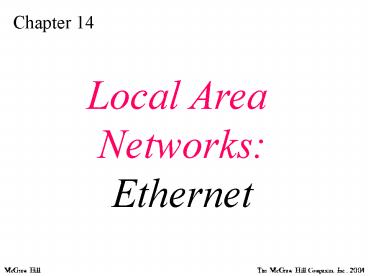Local Area Networks: Ethernet PowerPoint PPT Presentation
1 / 20
Title: Local Area Networks: Ethernet
1
Chapter 14
Local Area NetworksEthernet
2
14.1 Traditional Ethernet
Physical Layer
MAC Sublayer
Bridged Ethernet
Switched Ethernet
Full-Duplex Ethernet
3
Topology of the Ethernet LAN
- Each PC connected to the network is called a
node, and has a unique hardware address - Nodes are connected together along a common
cable, or via a hub or switch - The applications (programs such as windows and
word processors, spreadsheets etc.) are stored on
file-servers. Other servers give internet access
and email services - Printer servers are connected to the network
4
Network Topology
File Servers
Network Leg
Hub
High Speed Switch
Network Leg
PC nodes
5
Figure 14.10 Categories of traditional Ethernet
Note these are all Ethernet even though the
medium is different in each case
6
Figure 14.11 Connection of a station to the
medium using 10Base5
10Base5 10Mbps Baseband signalling 500m max
segment Often called Thicknet
7
Figure 14.12 Connection of stations to the
medium using 10Base2
10Base2 10Mbps Baseband signalling max 200m
segment (actually 185m) Often called Thinnet
50 ohm Terminator
8
Figure 14.13 Connection of stations to the
medium using 10Base-T
10Base T 10Mbps Baseband signalling Twisted
pair cable (max 100m) Current cable spec. is cat
5 which supports 100Mbps The university uses
this system - hubs are replaced by switches in
modern implementations
100Base T 100Mbps version of 10BaseT running
over cat 5 cable
9
Figure 14.2 802.3 MAC frame
Physical layer - ensures synchronisation
Data link layer carries data
- DSAP Destination service access point
- SSAP Source service access point
- both define the type of service expected at
layer 3 - e.g. IP, IPX (Novell), SNA (IBM)
10
Figure 14.3 Minimum and maximum length
11
Figure 14.5 Unicast and multicast addresses
Typical 48 bit hexadecimal network card MAC
address
6-byte MAC addresses must be unique they are
burned onto a network card during
manufacture. Each card manufacturer has been
allocated a range of addresses it may use. There
are 248 281,474,976,710,656 possible MAC
addresses available (about 50,000 for each person
alive today)
One bit of byte 1 has special significance it
allows multicasting
12
Figure 14.6 Physical layer
Combined within network card
13
Figure 14.7 PLS
14
Figure 14.9 MAU (transceiver)
15
Figure 14.16 A network with and without a
bridge
In (a), all frames from all nodes are sent to all
other nodes creating unnecessary traffic on the
network. A bridge is a layer 2 device. It
does not always pass frames across to the other
segment, but listens to source MAC addresses
from frames on each side, and builds up a
bridging table. It only passes a frame across
if its destination is on the other side. In this
way, the number of collisons is significantly
reduced, since most frames are meant for nodes on
the same side of the bridge. Thus two collision
domains are created.
16
Figure 14.17 Collision domains in a nonbridged
and bridged network
In (b), unnecessary network traffic is reduced by
a factor of 4
17
Figure 14.18 Switched Ethernet
A hub or repeater passes all frames without
address checking layer 1 devices A bridge
checks addresses, but only allows a single data
path from one port to another at any given time A
switch checks addresses, and allows multiple data
paths at the same time, creating very small
collision domains. Switches are now commonplace
18
Figure 14.19 Full-duplex switched Ethernet
Cat 5 cable consists of two twisted pairs full
duplex
19
Collision Detection
- The maximum time for a collision to be detected
is 2T, where T is the propagation time through
2.5 Km cable and 4 repeaters - For a 10Mb/s LAN this corresponds to 51.2uS and a
packet size of 64 Bytes.
A
B
A
B
t0, packet starts from A
tT-dT, packet almost at B
A
B
A
B
tT, B starts to Tx
t2T, noise burst Rx at A
20
Performance of Ethernet
- Ethernet is a CSMA/CD system if CD was perfect,
channel efficiency would be 100 - Network cards have to wait if the channel is busy
- In practice, collisions cause the network cards
to wait, and retransmit. This takes time and
reduces the efficiency. - At about 30 of the theoretical max capacity,
there are more collisions and waiting than there
are successful transmissions. Above this, the
network falls over. - Token Ring is far more efficient under these
conditions, since it adopts a more ordered
approach

